Menus
- The hottest mid-range enduro bikes in comparison
- Comparison test Enduros: Part 2
- Conclusion
- BMW F 800 GS
- Triumph Tiger 800 XC
- MOTORCYCLE measurements
- Equipment / prices

Jahn
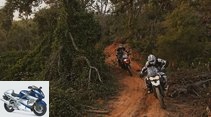
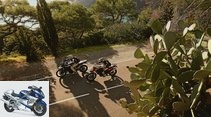
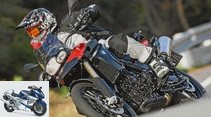
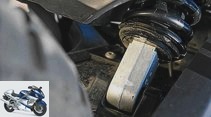
18th photos
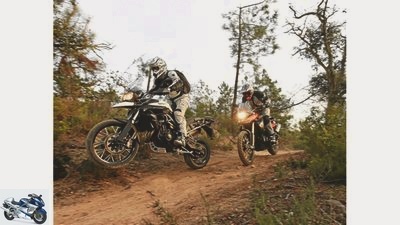
Jahn
1/18
Neither of them are averse to moderate off-road activities.
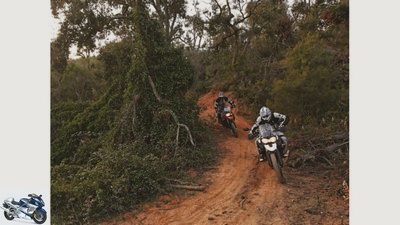
Jahn
2/18
The picture is deceptive. The Triumph cannot outpace the BMW off-road.
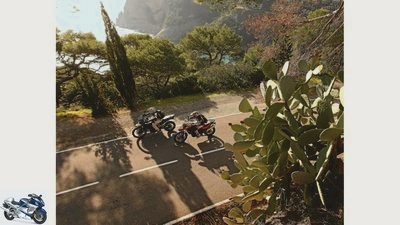
Jahn
3/18
As close as it is in the test between the two, both are good choices.

Jahn
4/18
Both the BMW F 800 GS and the Triumph Tiger 800 XC have a talent for dynamic inserts and relaxed strolling.
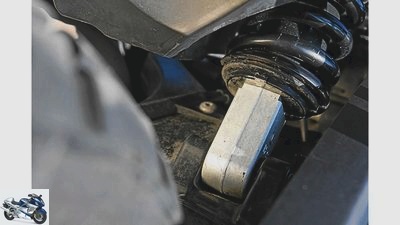
Jahn
5/18
The shock absorber does not need any complex rocker arms, but lies directly in the spray of the rear wheel.
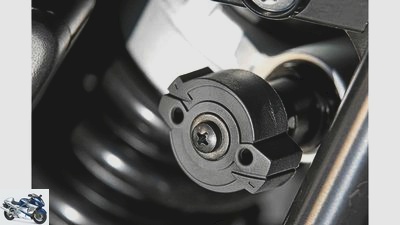
Jahn
6/18
Practical: hand wheel for changing the spring base. A tool for easier operation is under the seat.
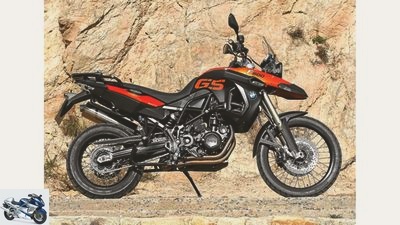
Jahn
7/18
BMW’s optional ABS can be switched off for off-road use.
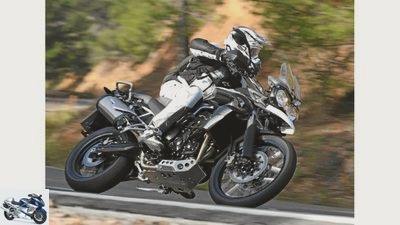
Jahn
8/18
The drive of the Triumph Tiger 800 XC scores with excellent smoothness.
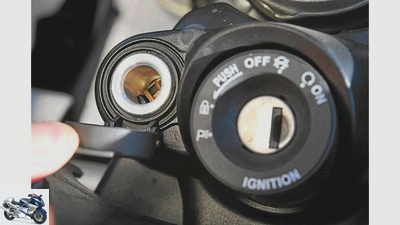
Jahn
9/18
The standard 12-volt socket is extremely practical next to the ignition lock.

Jahn
10/18
Not only the fairing carrier, but also the rear frame and passenger pegs are welded to the main frame.
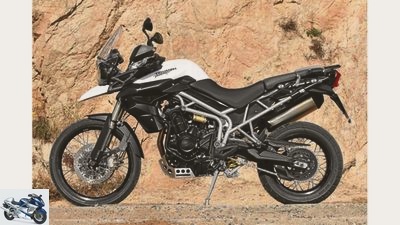
Jahn
11/18
Right from the start, equal to the top dog BMW F 800 GS, a successful debut.
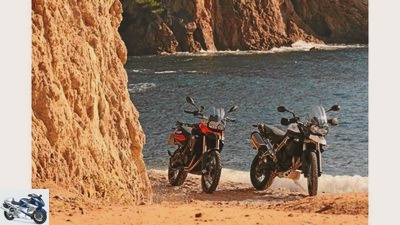
Jahn
12/18
Visually, too, the BMW F 800 GS and the Triumph Tiger 800 XC are in the same league.

Jahn
13/18
Balancing act: The BMW does a little easier in tricky passages.
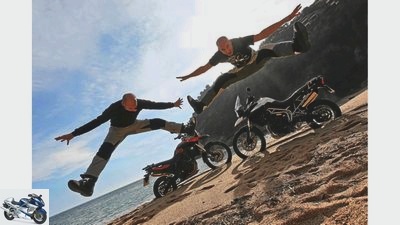
Jahn
14/18
The first test of strength between GS and Tiger XC is over. On points just slightly with the better end for the BMW F 800 GS.

Jahn
15/18
For traveling on and off the road there has been a constant for years, it’s called GS. Now the F 800 GS has had competition from England. The very promising Triumph Tiger 800 XC competes for the first time.
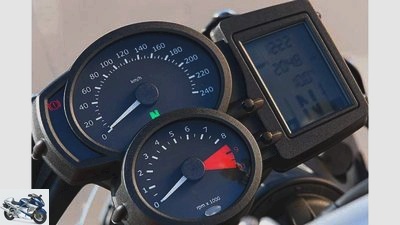
Marcus Jahn
16/18
The small and tightly labeled speedometer scale is only moderately readable. Gear and consumption display cost extra.
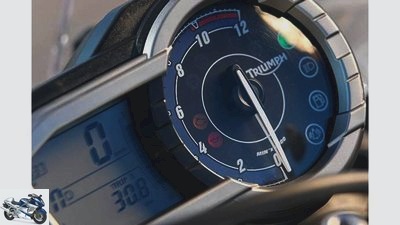
Marcus Jahn
17/18
The cockpit of the Triumph shines with extensive equipment and a clearly legible speedometer.
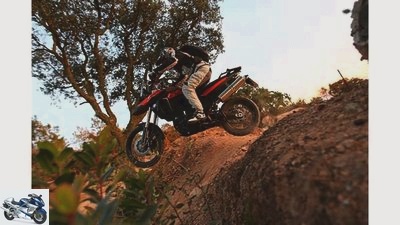
Marcus Jahn
18/18
The BMW is at home away from the road. She can easily cope with jumps.
Comparison test: BMW F 800 GS and Triumph Tiger 800 XC
The hottest mid-range enduro bikes in comparison
For years there has been a constant for travel on and off the road, it’s called GS. Now the F 800 GS has had competition from England. The very promising Tiger 800 XC competes for the first time.
La carretera de l’any, the annual road, is what the Catalans call the incessantly winding coastal road in northern Spain. Because it should have as many curves as there are days in the year. Is it true? We didn’t count. But could get there. Definitely the ideal terrain for travel enduro bikes like the BMW F 800 GS and the brand new Triumph Tiger 800 XC. After the Tiger 800 (for the sake of simplicity, let’s call it the Tiger 800, which is equipped with a 19-inch instead of a 21-inch front wheel and shorter suspension elements "Street tiger") in the Top test made a splendid debut, the tension was not only high in the editorial team, whether the Tiger 800 with the addition "XC" the top dog GS can dispute the territory.
After all, the street tiger already shone with remarkable everyday qualities and comfort. And with the same chassis, the XC adds a good shot of off-road suitability thanks to longer suspension travel.
VBut above all, she wears the same growling 800 three-cylinder. With a hefty 93 hp, it surpasses the not exactly weak-chested BMW twin by five hp. On twisted country roads like here, such number games are of secondary importance. Other qualities are required here. Acceleration, pulling power, fine manners.
Buy complete article
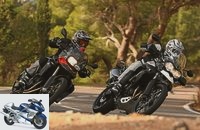
Comparison test: BMW F 800 GS and Triumph Tiger 800 XC
The hottest mid-range enduro bikes in comparison
Jahn
Both the BMW F 800 GS and the Triumph Tiger 800 XC have a talent for dynamic inserts and relaxed strolling.
The Tiger drive also scores with excellent smoothness. Even at high speeds, its mechanical expressions of life never take on disruptive dimensions. But in practice they are likely to remain the exception, especially since the vigor of the triumph noticeably fades from 8000 rpm. Regardless of this strong performance, the BMW twin turns out to be an equal opponent.
Acoustically, the bored in-line twin cylinder may not be a revelation. For a twin, however, it offers considerable smoothness, even runs just under 2000 rpm without whipping the chain and extremely low-vibration up to around 5000 rpm. When applying the gas at the apex of the curve, it largely suppresses the ugly load change jerk. In this way, switchbacks can also be mastered without doing magic with the clutch. And even if it does not react quite as spontaneously to commands from the throttle hand as the three-cylinder, only a blink of an eye separates it from the Triumph in terms of pulling power and acceleration thanks to the impressive torque curve, which already reaches its maximum at 5700 rpm.
In addition, he shows noticeably more ambition in the last third of the speed. However, combined with strong vibrations. So both have a talent for dynamic inserts and relaxed strolling.
In general, connoisseurs get their money’s worth at BMW and Triumph. Your relaxed seating invites you to savor the curved streets until the last ray of sunshine. Even in the highest position of the tightly padded bench, the Triumph embeds its rider a little deeper and more gathered than the BMW, but it is always relaxed. It also offers better wind protection, excellent consideration in the mirrors and a splendid light.
Nevertheless, the comfort rating goes to the BMW. With a generous knee angle, even more harmonious handlebar cranking and a bench that does not damage the seat meat even after hours in the saddle, the curve swing could go on forever.
Jahn
The drive of the Triumph Tiger 800 XC scores with excellent smoothness.
The BMW sweetened this with enormous maneuverability. In this regard, it also clearly puts the certainly not unwieldy Tiger in its place. The F 800 GS can easily be rocked from one lean angle to the next, where the Triumph wants to be brought on course and kept on track with a clearer message on the handlebars. The BMW tends to rush out of the curve on narrower lines. If you have to hit a hook when you are sloping around a stray dog or rubble that has tumbled down, the BMW does it with greater serenity.
And tilting it up is just as unfamiliar as the Triumph. The Tiger, on the other hand, scores with more precise steering, which is also the result of its overall tighter suspension setup. It’s nice that this firmness doesn’t come at the expense of comfort. Especially since the fork – in contrast to that of the road tiger – is sufficiently sensitive despite the tight rebound damping. However, it cannot provide feedback from the front wheel like the BMW. The BMW glides even more gently over patches and edges. Its spring elements respond more finely, the chassis tuning is clearly dedicated to comfort, but without causing you to stagger through the curves like a desert ship. The picture only changes at a more committed pace. Now the Tiger XC trumps. She sails confidently, with great stability and even greater inclination around elongated, flat and wavy arcs. And thanks to the longer spring elements, there is no interference from the side stand (like the street tiger).
Comparison test Enduros: Part 2
Jahn
Neither of them are averse to moderate off-road activities.
Even the BMW has no problems with the lean angle. But their softer spring elements and the otherwise flawless Michelin Anakee, which react to a tight pace with flexing movements, ensure a doughy driving feeling when robbing you that leaves no room for crisp precision. The hustle and bustle ends when colleague Karsten discovers a tiny, half-overgrown path towards the beach and therefore reaches mightily into the iron.
Braking is not a highlight for either of them. The F 800 GS can be optionally built with ABS support – ABS will only be available for the Tiger from March – and the braking performance is good. However, the muddy pressure point isn’t convincing. The Triumph’s double-disc brakes, which are also equipped with double-piston floating calipers, appear blunt and require a lot of manual force, which means that the ability to adjust the brake and the search for the locking limit suffer, even though the braking performance is okay.
In any case, both of them catch the junction without any problems. So now put it in the undergrowth and in the rests. BMW and Triumph not only exude a wanderlust aroma, they also master moderate off-road passages without any problems. And that even in the hands of off-road beginners.
The Triumph can be directed accurately through gutters and around tight bends. The fact that the engine still runs smoothly just above idle is very helpful. And for smaller hops, their spring elements offer more punch reserves than those of the BMW. However, the BMW makes the detour off-road even easier for its pilot. Thanks to fine, appealing spring elements, easier handling and a much narrower waist, it is easier to maneuver. The Michelin Anakee offer a little more grip than the Bridgestone Battle Wing of the Triumph, and the Twin helps over small obstacles more easily with more binding grip on short thrusts.
Jahn
As close as it is in the test between the two, both are good choices.
Even inexperienced people can do just fine. After a short balancing act over a narrow, half-ruined wall, the beach is reached. A short pause, let your eyes wander. The processing can be seen in both. Neatly laid electrics, stainless steel manifolds are pleasing to the eye. The Triumph even offers things with a height-adjustable bench seat, hand protectors and on-board computer that cost extra at BMW (see Equipment / Prices box). Why the adjustable clutch lever is only available at an extra charge remains a mystery. The BMW has it. You won’t find a foldable knob on the gearshift lever to protect against minor slips in the field with either.
The only serious point of criticism of the Triumph is perhaps that the fairing bracket, rear frame and passenger pegs are not screwed to the frame, but welded on. A small fall can quickly have costly consequences.
The winter sun seems to have shot its powder, dark clouds pile up, the first drops are falling. Now let’s go back. Karsten rushes ahead quickly and yet relaxed. Because the BMW inspires a lot of trust even under these conditions and the Michelins shine with great wet grip. The Bridgestones of the Triumph, however, get out of step earlier when wet. And the reduced feeling for the brakes and front wheel inhibits the forward thrust.
The BMW arrives at the gas station in front of the base camp with a clear lead. With 4.9 liters per 100 kilometers, the Triumph is cautious. The BMW, however, sips its fuel with 4.2 liters of fuel. But because the 19-liter Tiger can hold three liters more than the BMW, both have to go to the pump practically the same time.
At the end, what must come: the sober settlement between two practically equally strong, but quite different opponents in terms of character. If the Triumph scores with the creamy treble, the BMW counters with finer handling. The BMW throws comfort against the stability of the Tiger. And in the end – even without taking the ABS into account, but due to the more extensive equipment – the nose is wafer-thin ahead.
Conclusion
Jahn
The picture is deceptive. The Triumph cannot outpace the BMW off-road.
1st place: BMW F 800 GS
Manoeuvrable, balanced, with distinctive long-distance comfort. The BMW with its economical, powerful twin is recommended for comfort-conscious long-distance travelers.
2nd place: Triumph Tiger 800 XC
An extremely cultivated, agile three-cylinder, plus a stable chassis and extensive equipment. The Triumph combines long-distance suitability with dynamism.
who wins?
The first test of strength between GS and Tiger XC is over. On points just close to the better end for BMW. First of all. There is a simple reason that she competed here with the Triumph without ABS: All test motorcycles from BMW are equipped with the anti-lock device, but the Tiger models will only be available with it at the beginning of March. The ABS of BMW can be calculated from the points evaluation. It is quite possible, however, that after the positive experience with the sensitively regulating ABS of the Triumph Speed Triple (MOTORRAD 2/2011), the system of the Triumph wins more points than the rather coarse ABS of the BMW, and thus catches up or even equalizes their point advantage. In addition, the F 800 GS was equipped with optional accessories such as a main stand that was not yet available for the Tiger at the time of the test. Although this is at the expense of the price-performance rating, it also earns points. The haggling over every point also shows the high level at which both are moving, whereby the Triumph practically creates a stalemate right away. Therefore, there will be another meeting of the two, with the same equipment.
Scoring
Category engine:
If you want to criticize something about the Triumph three-cylinder, it might be that its vigor is noticeably flagged at the top. Otherwise, however, he delivers an impeccable performance in all respects. Even the transmission is a delight and works smoother than that of the BMW. Just like the strong vibrations at high engine speeds, this must not hide the fact that the BMW twin also cuts a fine figure.
Winner engine: triumph
Category chassis:
The revenge for the defeat in the engine chapter follows promptly. Noticeably handier and more comfortable, the BMW eagerly collects points. The stiffer spring elements give the Triumph more precise steering behavior and advantages in cornering stability, which is very clear when driving in a sporty manner. And the Tiger also runs more confidently in a straight line on the autobahn, which is also thanks to the Bridgestone tires.
Chassis winner: BMW
Category everyday life:
The parade discipline of the two. With a payload of over 210 kilograms, a wide range of equipment and practical controls, as well as a range of over 380 kilometers, they are well equipped for everyday life. The Triumph offers the slightly better light – especially the high beam has it all – and more wind protection. The BMW for the higher seating comfort. Co-drivers feel very comfortable on both. The only thing missing from the BMW is a larger tank.
Winner everyday: triumph
Category Security:
The Triumph’s floating caliper brakes bite a little listlessly and require a lot of hand strength. The BMW does that better despite the indifferent pressure point. Very pleasant: no righting moment when braking in an inclined position with both.
Safety winner: BMW
Category costs:
The BMW is easy on the wallet not only with its very low consumption, but also when it comes to inspection costs.
Winner costs: BMW
| Max points | BMW | triumph | Overall rating | 1000 | 660 | 644 |
| placement | 1. | 2. | Price-performance note | Top grade 1.0 | 1.8 | 1.6 |
Price-performance winner: Triumph
A clear price advantage with practically the same number of points are a strong argument for the Triumph.
BMW F 800 GS
Jahn
BMW’s optional ABS can be switched off for off-road use.
engine:
Water-cooled two-cylinder four-stroke in-line engine, two overhead, chain-driven camshafts, four valves per cylinder, bucket tappets, dry sump lubrication, injection, Ø 46 mm, regulated catalytic converter, 400 W alternator, 12 V / 14 Ah battery, mechanically operated multi-disc oil bath clutch, six-speed gearbox, O-ring chain, secondary ratio 42:16.
Bore x stroke 82.0 x 75.6 mm
Displacement 798 cc
Compression ratio 12.0: 1
rated capacity 62.5 kW (85 PS) at 7500 rpm
Max. Torque 83 Nm at 5750 rpm
landing gear:
Steel tubular frame, load-bearing motor, upside-down fork, Ø 45 mm, two-arm swing arm made of aluminum, central spring strut, directly hinged, adjustable spring base and rebound damping, double disc brake at the front, Ø 300 mm, double-piston floating calipers, disc brake at the rear, Ø 265 mm, single-piston -Swimming saddle.
Spoked wheels with aluminum rims 2.15 x 21; 4.25 x 17
Tires 90 / 90-21; 150 / 70R 17
Tires in the Michelin Annakee 2 test
Mass and weight:
Wheelbase 1578 mm, steering head angle 64.0 degrees, caster 117 mm, spring travel f / h 230/215 mm, seat height * 880 mm, weight with a full tank * 225 kg, payload * 218 kg, tank capacity / reserve 16.0 / 4.0 liters.
Guarantee two years
Service intervals 10000 km
Colours Orange / black, white / black
price 10150 euros
Price test motorcycle** 11500 euros
Additional costs around 269 euros
* MOTORCYCLE measurements
**Incl. ABS (710 euros), main stand (120 euros), on-board computer (145 euros), heated handles (195 euros), white LED indicators (95 euros), luggage rack (85 euros)
Triumph Tiger 800 XC
Jahn
Right from the start, equal to the top dog BMW F 800 GS, a successful debut.
engine:
Water-cooled three-cylinder four-stroke in-line engine, one balancer shaft, two overhead, chain-driven camshafts, four valves per cylinder, bucket tappets, wet sump lubrication, injection, Ø 44 mm, regulated catalytic converter, alternator 645 W, battery 12 V / 14 Ah, mechanically operated multi-disc oil bath clutch , Six-speed gearbox, x-ring chain, secondary ratio 50:16.
Bore x stroke 74.0 x 61.9 mm
Displacement 799 cc
Compression ratio 11.1: 1
rated capacity 70.0 kW (95 PS) at 9300 rpm
Max. Torque 79 Nm at 7850 rpm
landing gear:
Steel lattice frame, upside-down fork, Ø 45 mm, two-arm swing arm made of aluminum, central spring strut with lever system, adjustable spring base and rebound damping, double disc brake at the front, Ø 308 mm, double-piston floating calipers, disc brake at the rear, Ø 255 mm, single-piston floating caliper.
Spoked wheels with aluminum rims 2.50 x 21; 4.25 x 17
Tires 90 / 90-21; 150 / 70R 17
Tires in the test Bridgestone Battle Wing BW 501/502 "G"
Mass and weight:
Wheelbase 1568 mm, steering head angle 66.9 degrees, caster 91 mm, suspension travel v / h 220/215 mm, seat height * 855-875 mm, weight with a full tank * 225 kg, payload * 213 kg, tank capacity 19.0 liters.
guarantee two years
Service intervals 10000 km
Colours White, black, yellow
price 9590 euros
Price test motorcycle** 9759 euros
Additional costs around 350 euros
* MOTORCYCLE measurements
**Incl. Aluminum oil pan protection (169 euros)
MOTORCYCLE measurements
archive
The performance diagram of the two enduros.
The Triumph’s performance curve is almost exemplary. And it is precisely this uniformity that ensures relaxed driving. On the plus side, the three-cylinder with its velvety barrel and intoxicating sound offers something for the heart. Nevertheless, the BMW Twin is a successful drive that may not be able to compete in terms of sound, but is gripping in nature with its handsome torque curve and almost ensures a tie in terms of performance.
Maximum speed (manufacturer information):
| Km / h | BMW | 204 |
| triumph | 204 |
acceleration:
| 0-100 km / h | 0-140 km / h (sec) | BMW | 4.0 | 7.1 |
| triumph | 4.0 | 7.0 |
Draft:
| 60-100 km / h | 100-140 km / h | 140-180 km / h (sec) | BMW | 4.4 | 5.2 | 8.9 |
| triumph | 4.1 | 5.1 | 8.7 |
Fuel consumption (country road):
| Liters / 100 km | |
| BMW |
Super 4.2 | triumph | Super 4.9 |
Theoretical range (country road):
| Km | |
| BMW | 381 | triumph | 388 |
Equipment / prices




18th photos
Pictures: Comparison test: BMW F 800 GS and Triumph Tiger 800 XC
To home page
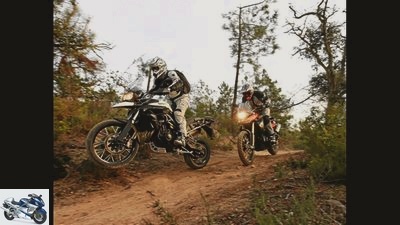
Jahn
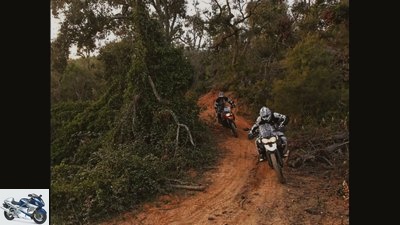
Jahn
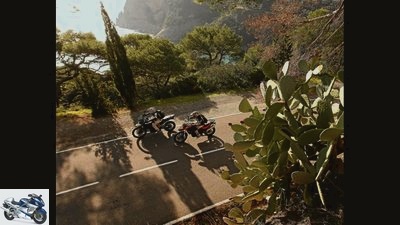
Jahn
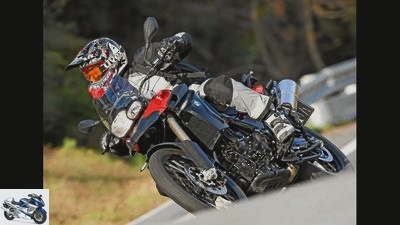
Jahn
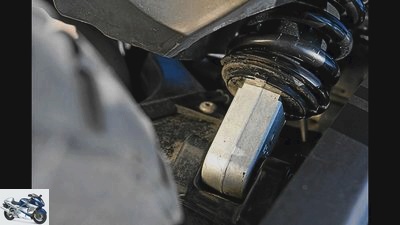
Jahn
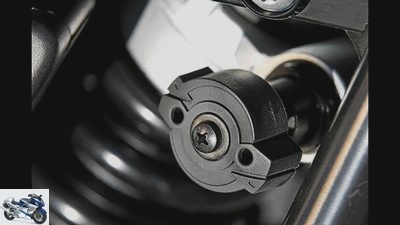
Jahn
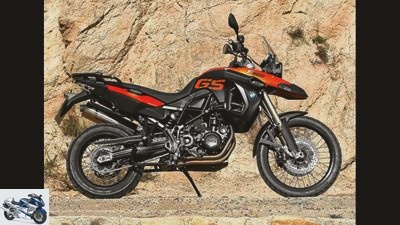
Jahn
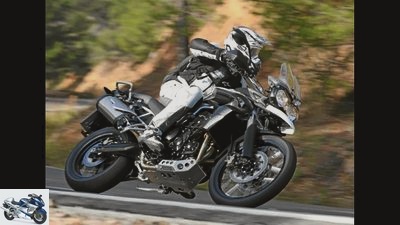
Jahn
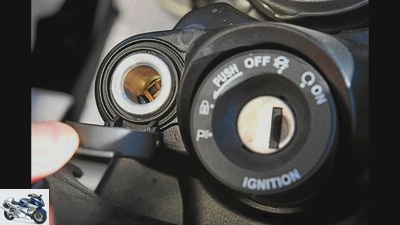
Jahn

Jahn
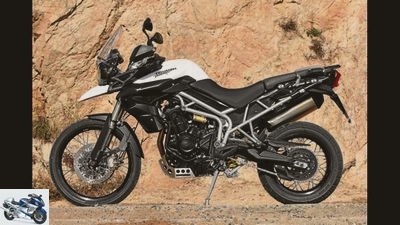
Jahn
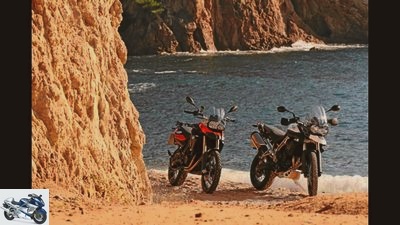
Jahn
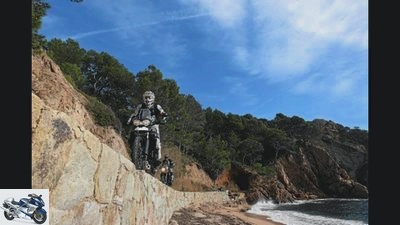
Jahn
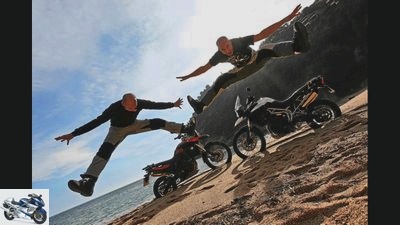
Jahn
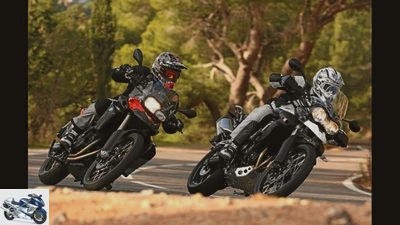
Jahn

Marcus Jahn
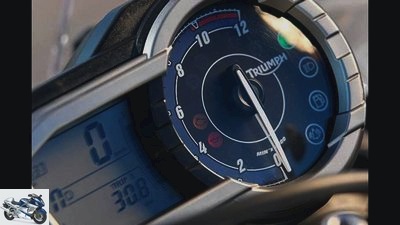
Marcus Jahn
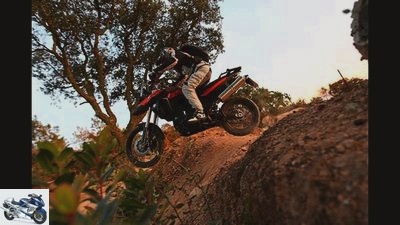
Marcus Jahn
Related articles
-
BMW F 800 GS and Triumph Tiger 800 XCx in comparison test
fact 37 pictures fact 1/37 Triumph Tiger 800 XCx. Triumph 2/37 Not a bargain, but a two plus proves: The Triumph Tiger 800 XCx offers a lot of technology …
-
Driving report Triumph Tiger 800 XCx and XRx
triumph 31 photos triumph 1/31 triumph 2/31 triumph 3/31 triumph 4/31 triumph 5/31 triumph 6/31 triumph 7/31 triumph 8/31 triumph 9/31 triumph 10/31…
-
Endurance test final balance Triumph Tiger 800 XC
Bilski 17 pictures mps photo studio 1/17 The Triumph Tiger in the 50000km long-term test. The final balance. mps photo studio 2/17 Typical Tiger: In Tuscany ….
-
Triumph Tiger 1200 XCa in the test
Triumph 8 pictures Triumph 1/8 Stronger, lighter and equipped with new features, the Triumph Tiger 1200 is heading towards 2018. Triumph 2/8 Amazing …
-
Top test Triumph Tiger The tiger is loose Now it’s gone, the tiger. Escape from the cage and tank, the lithe big cat goes on the hunt …
-
Triumph Tiger Explorer – competition for the BMW GS
Triumph driving report: Triumph Tiger Explorer Competition from England for the BMW GS After the Tiger 800, Triumph is now bringing the second GS clone: the Tiger …
-
24 pictures Triumph 1/24 Triumph Tiger 800: The three-cylinder engine generates 95 hp at 9300 rpm from 799 cubic meters. Triumph 2/24 Triumph Tiger 800 XC …
-
BMW, Kawasaki, Triumph and Yamaha Tourer in comparison test
Gargolov 31 pictures Gargolov 1/31 Tourer comparison test: Triumph Trophy SE, BMW R 1200 RT, BMW K 1600 GT, Yamaha FJR 1300 and Kawasaki 1400 GT. Gargolov …
-
Test Triumph Tiger, model 2004
Bilski Test Triumph Tiger, model 2004 Sharpened claws S. he was missing, the tigers, in the comparison test of the travel enduro bikes in MOTORRAD…
-
Jahn 34 Pictures Jahn 1/34 Jahn 2/34 Lonely: The KTM is the only one of the Adventure Enduros to stay with chain drives. Light, but in need of care. Jahn 3/34 …